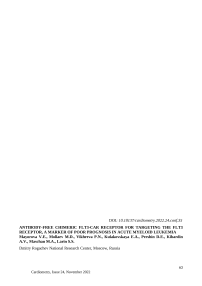Antibody-free chimeric FLT3-car receptor for targeting the FLT3 receptor, a marker of poor prognosis in acute myeloid leukemia
Автор: Mayorova V.E., Mollaev M.D., Vikhreva P.N., Kulakovskaya E.A., Pershin D.E., Kibardin A.V., Maschan M.A., Larin S.S.
Журнал: Cardiometry @cardiometry
Статья в выпуске: 24, 2022 года.
Бесплатный доступ
Therapy in acute myeloid leukemia (AML) usually begins with a course of induction chemotherapy using anthracyclines and cytarabine to eliminate blast cells. Chemotherapy is a necessary step in preparing a patient for transplantation of donor hematopoietic stem cells (HSCs). However, leukemia stem cells often show their chemoresistance and initiate the AML recurrence. Specific elimination of the leukemic stem cells during the preparation of a patient for HSC transplantation may reduce the probability of recurrence. For this purpose, an active development of chimeric antigen receptors (CAR) to address various markers of AML is being in progress.
Короткий адрес: https://sciup.org/148326329
IDR: 148326329 | DOI: 10.18137/cardiometry.2022.24.conf.35
Текст статьи Antibody-free chimeric FLT3-car receptor for targeting the FLT3 receptor, a marker of poor prognosis in acute myeloid leukemia
Dmitry Rogachev National Research Center, Moscow, Russia
Therapy in acute myeloid leukemia (AML) usually begins with a course of induction chemotherapy using anthracyclines and cytarabine to eliminate blast cells. Chemotherapy is a necessary step in preparing a patient for transplantation of donor hematopoietic stem cells (HSCs). However, leukemia stem cells often show their chemoresistance and initiate the AML recurrence. Specific elimination of the leukemic stem cells during the preparation of a patient for HSC transplantation may reduce the probability of recurrence. For this purpose, an active development of chimeric antigen receptors (CAR) to address various markers of AML is being in progress.
The concept of CAR T-cell therapy is based on an introduction of an artificially engineered genetic construct of a chimeric CAR receptor into a patient's T-cells ex vivo.
The chimeric CAR receptor is a transmembrane protein, the extracellular part of which recognizes the molecular target: the tumor antigen. As a result of recognition of the target molecule on the cell surface, the chimeric CAR receptor is activated, triggering the T-cell killing mechanisms. A singlechain fragment of the variable part of an antibody (scFv) as an extracellular part of the chimeric CAR receptor is conventionally used, which specifically recognizes the target molecule. The scFv sequence is based on the sequence of the corresponding known monoclonal antibody. The design of the scFv sequence for the chimeric receptor includes the selection of an eligible linker to bind the variable fragments of a monoclonal antibody into one chain as well as the study of the stability of the obtained scFv protein at various pH values and temperatures, testing the affinity to the target molecule and specificity of its interaction with the latter. An original approach is to use as an extracellular part of a chimeric receptor a part or a full-length natural ligand of a tumor antigen in the case when the latter is a receptor. Being the original ligand, the extracellular part of the chimeric receptor shall be capable of specifically, with known affinity, recognizing the target molecule.
The advantage of the development of this sort of antibody-free chimeric receptors is the availability of a large body of research evidence data on the structures and functional domains of proteins that may considerably accelerate design and development of the CAR T-therapy.
The most common are at least eight types of AML. There is a variety in the immunophenotypes of blast cells in different types of AML. The blast cells in AML develop clonally, each clone is characterized by its own independent set of surface markers. In addition, the immunophenotype of the blast cells of the same type of AML in different patients may vary significantly, and it may also alter with time. In case of AML, a promising way may likely to be the development of a number of CAR T-cell approaches specific with respect to various tumor antigens. Thus, based on the results of the diagnostic immunophenotyping of the blast cells in a particular patient, it would be possible to select the appropriate variant of the CAR T cells.
Aims and methods . For this study, the Flt3 tyrosine kinase receptor was chosen as a molecular target. Being excessively available on the surface of blast cells in AML, Flt3 often persists in 64
recurrences. In ~30% of the AML cases, the Flt3 sequence carries an activating mutation (ITD), making it an attractive target molecule. To target the Flt3 receptor, the full-length sequence of the natural Flt3 receptor agonist – the Flt3 ligand was taken as the recognition extracellular part of the antibody-free chimeric Flt3-CAR receptor.
Results . In the course of our research work, the antibody-free Flt3-CAR T cells were engineered, where the Flt3 tumor antigen-recognizing function was undertaken by the full-length natural Flt3 ligand instead of scFv. The antibody-free Flt3-CAR T cells were shown to specifically eliminate the Flt3-positive THP-1 cells and did not affect the proliferation of the Flt3-negative U937 cells. The antibody-free chimeric Flt3-CAR receptor was not cytotoxic against the Flt3-positive THP-1 cells; their elimination required activation of the T-cell killing mechanisms. The recognition by the chimeric Flt3-CAR T cell receptor of the Flt3 receptor on the surface of the target cells occurred via the Flt3:Flt3 ligand interaction interface.
Conclusion . Thus, we have succeeded in designing and engineering of highly specific antibody-free Flt3-CAR T cells with clear mechanisms of activation and recognition of the target molecule.


